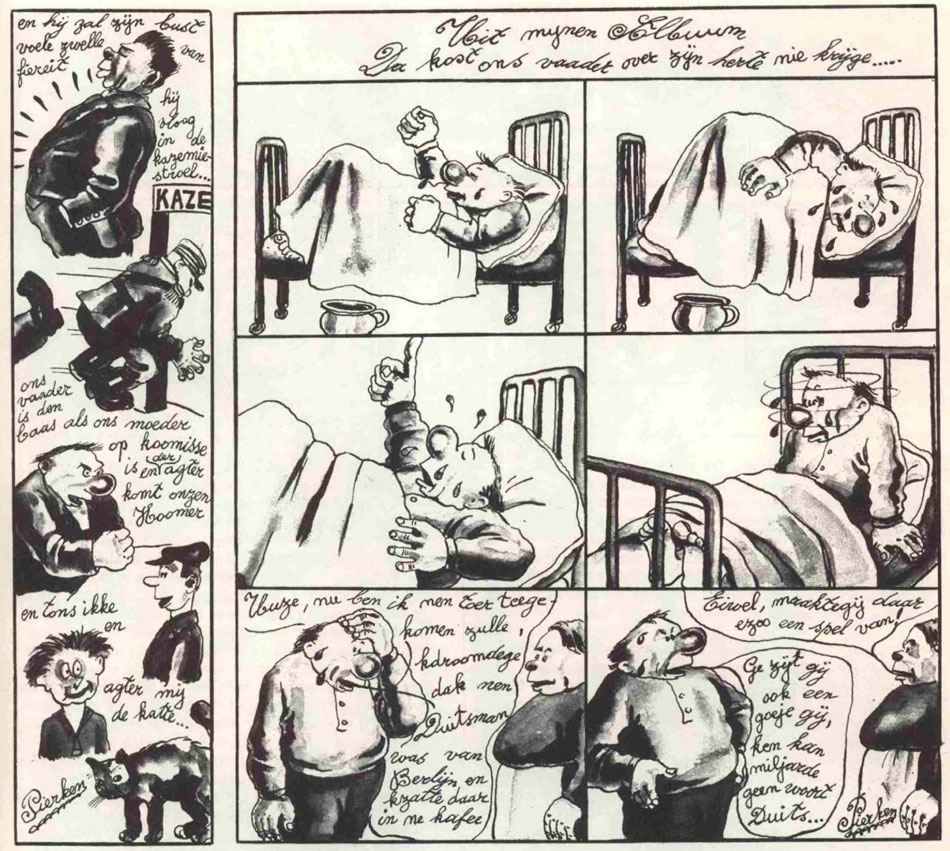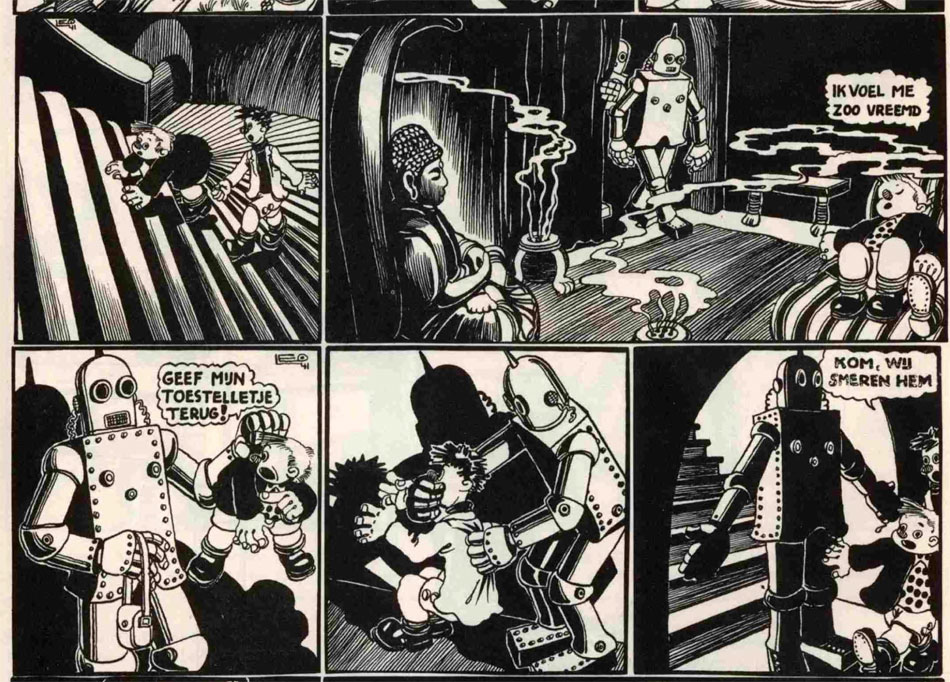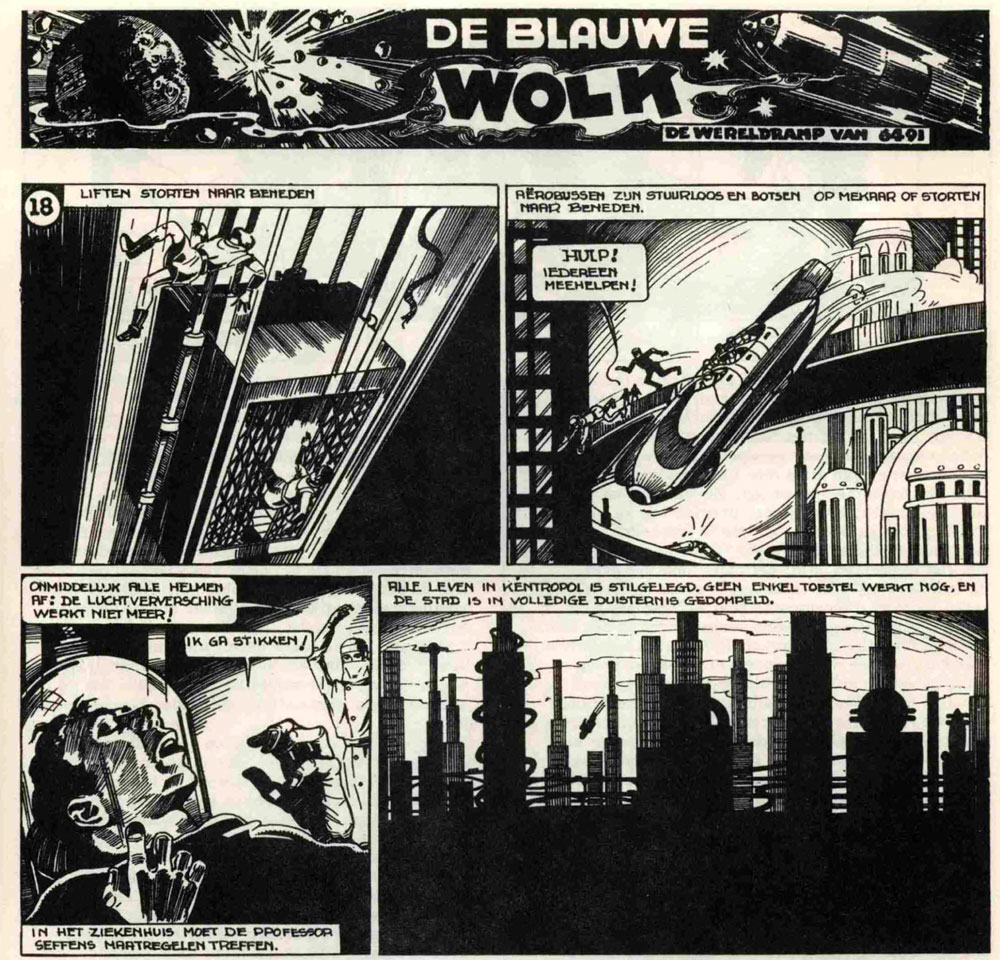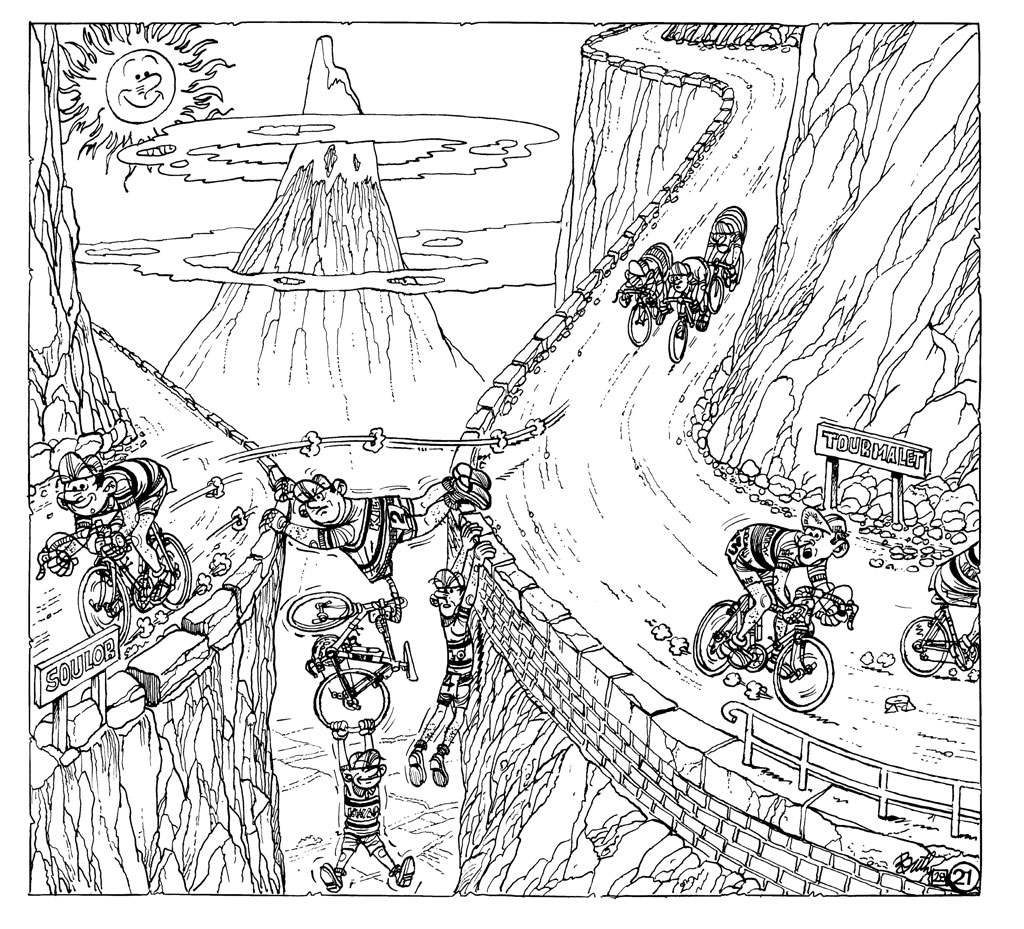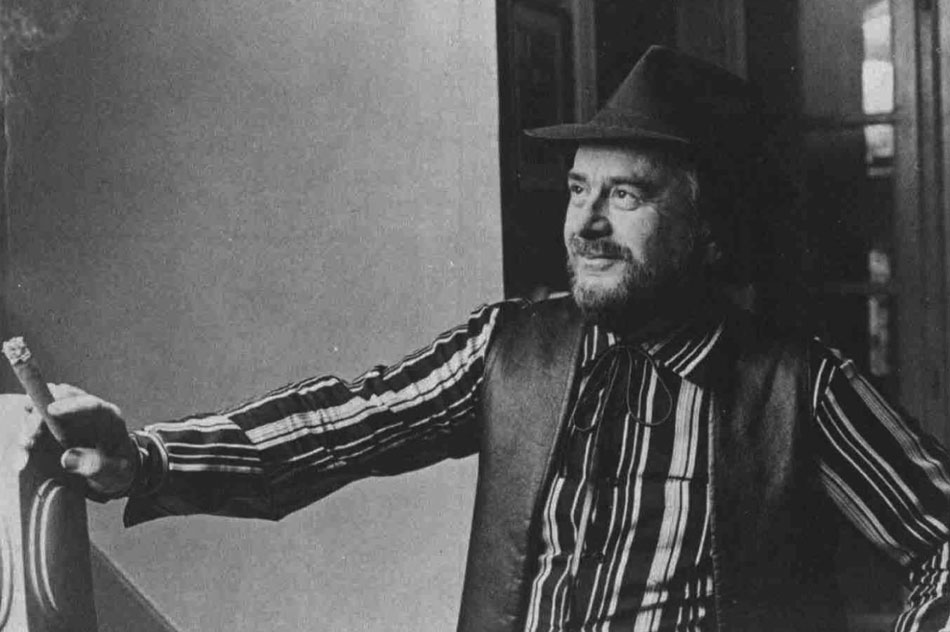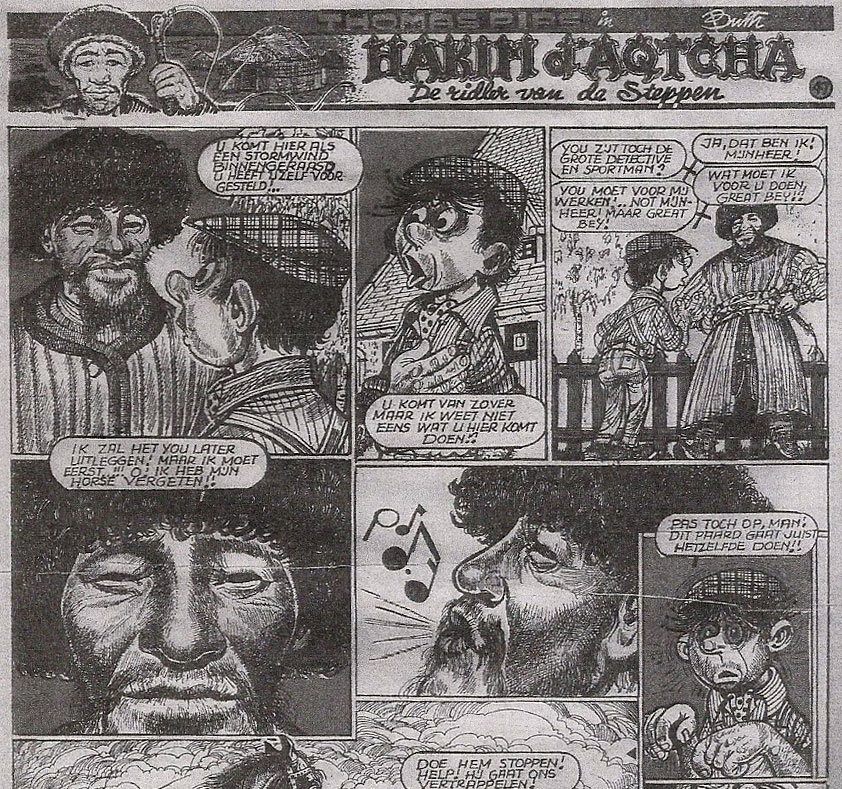'Thomas Pips', cover illustration for 'Het Kasteel der Schaduwen' and 'In De Greep van Mysteras'.
Leo De Budt, who signed his work with "Buth", was a Belgian comic artist, illustrator and painter. One of the more productive artists of his generation, he began his career during the 1930s in the socialist newspaper Vooruit, then appeared in the Nazi-controlled press during World War II, before finding a homebase in post-war Roman-Catholic newspapers and magazines. His best-known creation was 'Thomas Pips' (1946-1985), a humorous detective strip and occasional gag comic, running for almost four decades in, subsequently, Ons Zondagsblad and 't Kapoentje. As an artist, Buth easily switched between a cartoony and a more realistic style. In this latter category, his longest-running series was 't Kapoentje's historical-educational feature 'Vader Kapoen Vertelt' (1969-1982). Buth is additionally remembered for his annual Tour de France cartoons (1947-1982) in the newspaper Het Volk, which have urged generations of competitive readers to find the hidden mouse in each drawing. Over the course of his career, he also illustrated various one-shot adventure comics and literary stories for 't Kapoentje, Het Volk, Ons Zondagsblad, De Gentenaar and the children's magazines Zonneland and Tam-Tam. In the 1960s, he was one of three cartoonists who designed the "technical difficulties" cards for the public TV channel B.R.T.
Early life and career
Leo De Budt was born in 1919 in The Hague, The Netherlands, as the son of Flemish immigrants. When the First World War broke out, the De Budt family had fled to The Netherlands, since that country remained neutral during the conflict. In 1922, the family returned to Belgium and settled in Ghent. Buth's father Victor De Budt (1886-1965) was a fine arts painter, as well as a teacher at the Academy of Ghent. Originally, Leo De Budt wanted to become a doctor, but his father was good friends with the expressionist painter Frits Van den Berghe, who encouraged the young boy to study art at the Sint-Lucas School of Arts in Ghent and take evening lessons at the local Academy.
At the time, Van den Berghe drew comics for the socialist newspaper Vooruit and wanted to train Buth into becoming his assistant. At the Academy, Buth also took classes from Jos Verdegem, whom he considered his mentor. Among his main graphic influences, Leo De Budt ranked painters like the Flemish Primitives and Albrecht Dürer. In the field of comics, he took inspiration from Harold Foster's 'Prince Valiant', Alex Raymond's 'Flash Gordon' and Chic Young's 'Blondie', as well as the European artists Bob De Moor, Alain Saint-Ogan and Robert Velter.
Continuation by Leo De Budt of Frits van den Berghe's comic 'Uit Mijnen Album', starring the character Pierken (1939-1940).
In 1936, Buth made his earliest comics, cartoons and illustrations as assistance work for Van den Berghe, published in the local Ghent socialist daily Vooruit. He also livened up a weekly cartoon page in the radio magazine Radiobode, made games and illustrations for Bravo! magazine and, from 1939 on, made cartoons in the military magazine De Pinnekensdraad. When Fritz Van den Berghe passed away in September 1939, Buth continued doing his work in Vooruit, including the comic strip 'Uit Mijnen Album' and the illustrations for articles by Gaston Gramme. He also filled Van den Berghe's spot in Voor Allen for a while, until in May 1940 World War II interrupted everything. As the Nazis occupied Belgium, Buth asked his father to visit the now largely abandoned office of Vooruit to pick up his cartoons. Some of his caricatures poked fun at Hitler and he wanted to avoid them being found.
In 1942, Buth married the Belgian-Japanese Germaine De Corte (1921-2014), who was also an artist, known under the names Iko Anaka and Manja. The couple had two children.
World War II
During World War II, Buth - at the time signing with "Leo" - published in various newspapers and magazines controlled by the Nazi press, including Vooruit, Volk en Staat, De Nationaalsocialist, De Blauwvoet, De SS-man, De Vlaamsche Post, Stemmen uit Duitsland and Balming. His contributions varied from innocent children's comics to antisemitic cartoons and Nazi propaganda. From 26 January 1941 on, Buth's pantomime gag comic 'Mijnheer Dinges' ran in Vooruit, his old homebase which was now under Nazi control. For the national-socialist newspaper Volk en Staat, Buth drew the daily children's comic 'De Wereldreis van Flip en Flop' (starting on 21 April 1941), about two boys traveling across the globe. In 2008, this specific story was reprinted in book format by Brabant Strip. Buth's fantasy comic 'Gawain, de Dappere' (1943-1944) ran in Balming and was strongly inspired by Alex Raymond's 'Flash Gordon'. In De Nationaal-Socialist, Buth drew the pantomime comics 'Hanske, de Vendelknaap' and 'Grietje, Het Kerlinneke' (1941), which promoted the youth division of the Flemish Nazi party VNV.
'De Wereldreis van Flip en Flop'.
In 1944, Buth and scriptwriter Karel Brandes, a former Vooruit colleague, adapted Josef von Báky's Nazi film 'Münchhausen' (1943) into a comic strip. Based on the novel of the same name by Rudolf Erich Raspe, 'Münchhausen' is notable as the only German movie produced during World War II to not be political propaganda. Also a straightforward fantasy adventure story, Buth's comic was published directly in book format by the Ghent publisher Het Licht/La Flamme: in Dutch language as 'De Dolle Avonturen van Baron von Münchhausen' and in French as 'Les Folles Aventures de Baron Münchhausen'.
Most of Buth's illustrations during this period were done for stories and columns by the Flemish poet and playwright Blanka Gyselen, who was politically active within the Flemish Nazi party DeVlag. They were for instance responsible for the children's and teenage sections in both Volk en Staat ('De Plezierige Vragenbus', 'Voor Ons Jonge Volkje') and Balming ('Voor Onze Jongeren'), with De Budt being referred to "Broer Leo" ("Brother Leo") and Gyselen as "Groote Zus" ("Big Sister"). After World War II, both Gyselen and Buth were convicted for their Nazi collaboration. On 30 June 1947, the artist was sentenced to six months imprisonment and a lifelong publication ban. To get around this ban, he started using the pseudonym "Buth", a misspelled variation of his last name. After a retrial in 1951, the ban was reduced to five years. Since that amount of time had already passed, the ban was lifted altogether on 27 March 1951.
Ivanov publications
After World War II, Buth became a prominent illustrator for the publications of the Ysebie family, who had built their business on the Ivanov story papers, written before the war by Sacha Ivanov, pen name of Rachel Ysebie-Van Overbeke (1888-1943). Already in 1943 and 1944, De Budt's wartime comics 'Mijnheer Dinges' and 'Flip en Flop' were reprinted in Ivanov's children's magazine Ons Rakkersblad. Starting in 1946, Buth made cover and interior illustrations for the story paper Ivanov's Verteltuurtjes (1946-1947) and its follow-up Ivanov's Nieuwe Verteluurtjes (1947-1948), and he was practically the sole illustrator of the annual 'Ivanov's Almanak 1947'. During the 1950s, he also made illustrations for the Ysebies' novel collections 'Ivanov's Grote Vervolgromans' and 'Ivanov's Romans' (1952-1953) and Kino Magazine.
Taptoe
Leo De Budt's main client after World War II became the Catholic newspaper Het Volk and its supplements. For the paper's short-lived supplement Taptoe, he drew the one-shot science fiction story 'De Blauwe Wolk: De Wereldramp van 6941' (7 April-14 November 1946), scripted by Raymond Jean de Kremer, AKA John Flanders. This marked the first of many times that Buth collaborated with Flanders. Buth regarded Flanders as difficult, since the novelist expected his illustrators to reproduce his stories as exact as possible, down to the lay-outs he dictated. Nevertheless, Buth eventually managed to create his own visual interpretations of Flanders' texts, regardless of what the author thought of them. For Taptoe, Buth also drew a comic based on medieval explorer Marco Polo, running from 21 November 1946 to 10 July 1947. In 1997, over 50 years after its first publication, 'De Blauwe Wolk' was reprinted by the publishing company Bonte and made available as a comic book.
Introduction strip of the 'Thomas Pips' gag strip (7 February 1946).
Thomas Pips
In the meantime, on 7 February 1946, Buth had modestly started his signature comic series in Taptoe's parent newspaper, Het Volk. Originally a family gag strip, 'Thomas Pips' revolved around the bumbling dad Thomas Pips, his wife Tin(n)eke, son Flip, daughter Mieke, Bobby the dog (later renamed Floppy) and Felix the cat. In many ways, the feature was comparable to Chic Young's family gag comic 'Blondie'. In spirit, but also visually, Thomas and Tineke were the spitting images of Dagwood and Blondie. Later, Buth redesigned the Tineke character so that she resembled his own wife. During its run of almost forty years, the 'Thomas Pips' comic itself underwent several changes too, often inspired by a change of format or writers.
After 'Thomas Pips' was concluded as a gag strip on 9 January 1947, the comic was retooled into a humorous adventure comic, starting in Het Volk on 1 August 1947 with the serial 'Het Geheim van de Vliegende Schotels'. By now, Thomas had become a detective, while his family members were written out of the series. They were replaced by new cast members, namely police officer Snoek, Giele the crow and the comic relief sidekick, Slappe Sys, who was originally a tramp. Until 26 June 1948, four episodes of the 'Thomas Pips' comic were scripted by the popular youth writer Raymond Jean de Kremer, better known under his pen names John Flanders and Jean Ray. After a brief return of the gag strip 'Fratsen van Thomas Pips', two new serialized adventures ran in Het Volk between 16 November 1948 and 28 June 1949. Working with the new writer Lod Lavki (pseudonym of the priest Ludovic Van Winkel, 1893-1954), Pips became a family man again, with his son Flip serving as sidekick.
Thomas Pips - 'Het Kasteel der Schaduwen' (1948).
On 24 September 1949, Het Volk moved the 'Thomas Pips' comic to its Sunday supplement Ons Zondagsblad, where it ran until 16 November 1952 as the gag comic 'Tribulaties van Thomas Pips & Co', after which it was replaced by Marc Sleen's 'Oktaaf Keunink' comic. Meanwhile, 'Thomas Pips' also appeared as an adventure and occasional gag comic in Het Volk's weekly children's supplement 't Kapoentje. Under the same title, 'Thomas Pips' also appeared in 't Kapoentje's French-language edition Le Petit Luron. From 21 June 1951 until 1952, Buth created two new serials with John Flanders as writer: 'Het Geheim van de Groene Sleutel' and 'De List van Bullakos'.
Thomas Pips - 'Herrie in de ronde' (1966).
It wasn't until 1958 before the 'Thomas Pips' comic returned in the pages of 't Kapoentje. Until 7 April 1965, Buth created 224 gag pages in which Thomas tried out another sport under the title 'Thomas Pips in Sport en Spel'. In 1965, Marc Sleen left Het Volk and its supplement 't Kapoentje to join the rival newspaper De Standaard. At the request of his editors, Buth once again remodeled 'Thomas Pips' into a children's adventure comic. Between 14 April 1965 and 1979, 48 new 'Thomas Pips' stories were serialized, this time all scripted by Buth himself. Storywise, Buth generally used a humorous mix of current events, folklore and science fiction. For the occasion, Thomas' son was renamed from Flip to Henkie, after the artist's second son, Henk. A new cast member was the next-door-neighbor Kilo, a tall and robust man, with whom Thomas is either good friends or fierce rivals. The final two 'Thomas Pips' stories in 1984 and 1985 were created in a completely different graphic rendition with much cross-hatching, inspired by expressionism.
During the 1960s and 1970s, newspaper Het Volk released several of the new 'Thomas Pips' adventure comics in book format. In the 1990s, the publishers Worldstrips and De Negende Kunst reprinted some rare episodes.
Tour de France cartoon by Buth. Spot the hidden mouse!
Tour de France
In addition to his 'Thomas Pips' comic strip, Buth also became a notable cartoonist for the newspaper Het Volk. In July 1947, the first post-war Tour de France was organized. It had been eight years since the last edition, so the media turned the return of this cycling event into a big spectacle. Het Volk launched a special Tour-themed paper, 'Speciale Editie voor de Ronde van Frankrijk', the first of its kind in the Belgian press. The instigator was Bart Lotigiers, head of Het Volk's sport edition and future head of the Ghent Opera (he was incidentally also the father of Belgian singer Helmut Lotti). To attract readers, their house cartoonists Marc Sleen and Buth made exclusive cartoons. Sleen made a daily cartoon that summarized each tournament in a humorous drawing, filled with caricatures of the cyclists. Buth illustrated a daily column, supposedly written by his signature character Thomas Pips, but in reality by journalist Michel Casteels. Each of his illustrations featured Thomas on his bike, amidst a crowd of onlookers, rival cyclists, reporters and other people. Apart from this Tour-themed paper, Sleen and Buth's cartoons also ran in Het Volk's regular sports columns.
While Sleen covered every Tour de France edition until 1964, Buth continued even longer, up until 1982. Some of his Tour-themed illustrations were used to liven up the books 'Tourgedichten' (1976) by Elle Saegeman and 'Tour de France Encyclopedia 1903-2003' by Guido Cammaert. A special comic by Buth about the Belgian cycling champion Eddy Merckx was published in book format as 'Eddy Merckx. Zo Is Er Maar Eén' (Worldstrips, 2010). Het Volk's Tour-themed papers were very popular at the time. Newspaper boys cycled around and across their towns to sell or deliver the latest editions. Others were brought to the airport of Sint-Denijs-Westrem, where sport planes dropped them all over Flanders. Buth's 'Thomas Pips' Tour de France cartoons have been collected in 'In de Ronde/ Dans le Tour' (Het Volk, 1980), which was reprinted twice by Worldstrips, in 1991 and 1995.
The 'Thomas Pips' sports cartoons by Buth are fondly remembered for their "find the mouse" puzzles. As a running gag, Buth hid one or more mice in each panel. The paper organized daily contests for readers to either look for one mouse or count how many rodents they could spot. Generations of Flemish readers have grown up searching for Buth's mice. In some Flemish neighborhoods, the activity was even part of their annual Tour festivities. For decades, Buth's Tour de France cartoons have been reprinted in Flemish newspapers, along with the mice-searching contests. In 2014, the newspaper Het Nieuwsblad brought out a special book, 'Zoek De Muizen van Thomas Pips in de Tour!', collecting all the "mice cartoon" reprints.
In 1982, Het Volk discontinued their annual Tour de France newspaper for three major reasons. New child labor laws made it impossible to hire minors to distribute the papers, while the airport of Sint-Denijs-Westrem closed down and television made sport fans' interest in the papers decline. Buth was very unhappy with this decision.
Story illustration for 'De Vreselijke Roos', a werewolf horror tale by John Flanders, printed in 't Kapoentje #12 of 21 March 1973.
't Kapoentje
During the 1950s, Buth had become a regular contributor to Het Volk's children's supplement 't Kapoentje. Besides comics, he also designed the headers of various weekly sections and livened up a great many text stories with illustrations. One of his early comics for the magazine was 'De Leugenbaron' (1950), a text comic take on the folkloric Baron Munchhausen character. Starting on 2 November 1950, he also serialized a fantasy version of the Flemish folklore character 'Tijl Uilenspiegel', which in 1955 was also published in book format by Sparta.
On 25 June 1969, Buth launched an educational comic series in this weekly, titled 'Vader Kapoen Vertelt' (1969-1982). The format was clearly inspired by the educational 'Les Belles Histoires de l'Oncle Paul' feature from Spirou magazine, originally created by Jean-Michel Charlier and Eddy Paape. Much like this series, a pipe-smoking fatherly figure told two children about the deeds of famous historical characters. In Spirou, the narrator was the uncle of the young listeners, while Buth's Vader Kapoen was a mustached father who told stories to his son and daughter. Before the launch of Buth's comic feature, as early as the 1950s, the character of Vader Kapoen had been used by editors of 't Kapoentje, albeit with a different look and only to introduce one-shot serialized stories and comics, drawn by Rik Clément. In his version of 'Vader Kapoen Vertelt', Buth made comic biographies of historical characters he personally found interesting, like the composer Gioacchino Rossini and the art forger Han van Meegeren. In 2018, the 'Vader Kapoen' stories were reprinted in book format by publisher Bonte, under the title 'Levensschetsen'.
'Het leven van Jezus' (Zonneland, 8 January 1961).
Catholic children's magazines
After World War II, Buth also became a regular contributor to Roman Catholic children's magazines. Between September 1948 and June 1950, he wrote and drew the serial 'De Avonturen van Joke en Maaike: Het Geheim van de Brousse' in Tam-Tam, the monthly magazine of the Holy Childhood.
Through his regular scriptwriter John Flanders, Buth also began a collaboration with Zonneland, a magazine of the Catholic publishing house Altoria in Averbode. With Flanders as writer, he created the naval adventure serial 'Op Zoek naar de Zonne-Eilanden' (17 April 1949 through 26 March 1950). However, Buth didn't feel at ease among the priests of the Averbode abbey, who edited the magazine, spearheaded by Nonkel Fons. It took until 14 August 1960 before he returned to the pages of Zonneland, this time with a devout biography of Jesus Christ, 'Het Leven van Jezus' (1960-1962). With the scriptwriter Rik Puttemans, he created six stories of the medieval epic 'De Moeraskerels' (1962-1965), as well as the adventure serials 'De Jongens van Black-House' (1965-1966), 'De Schat van het Goudschip' (1967-1968), 'Het Gezin van Marc Trenters' (1968-1969) and 'De Kinderen van het Gezin Trente' (1969). In between, he created 'De Zwijgende Parelvisser' (1966) from a script by H. Dufait and 'Vacantie aan de Grens' (1966-1967), written by L. Houthooft.
In the 2010s, several of Buth's comic serials for Zonneland were reprinted in comic books. Publisher Brabant Strip brought out 'Op Zoek Naar De Zonne-Eilanden' (2010), and Peter Bonte re-released 'De Moeraskerels' (2014) and the story collection 'Zonneland Verhalen' (2014).
Magazine and newspaper comics
From August 1947 until July 1951, Buth drew a series of cartoons for newspaper Het Volk titled 'Malcontenten', which depicted local news from the city of Ghent. Between 1953 and 1956, he created the gag comic 'Stanneke' in Handel en Ambacht, the union magazine for the local tradespeople of Ghent. Stanneke featured the busy life of a working man.
During the 1950s, readers of the weekly radio and TV magazine De Post could enjoy Buth's adaptations of literary classics, successively Charles De Coster's 'De Ware Geschiedenis van Tijl Uilenspiegel' (1953), the medieval poem 'Reinaert de Vos en zijn Euvele Daden in Nobels Rijk' (1953-1954), Rudolf Raspe's 'De Lotgevallen van de Baron van Münchhausen' (1954-1955), Hendrik Conscience's 'De Leeuw van Vlaanderen' (1955-1956) and Alexandre Dumas' 'De Drie Musketiers' (1956), most of which were published under the pseudonym Tijl. Between 1956 and 1957, De Post also ran Buth's comic biographies of Wolfgang Amadeus Mozart, Henry Stanley, Godfrey of Bouillon, Baden-Powell, Louis Pasteur, Pieter Bruegel and Adrien De Gerlache. In 1955 and 1956, three of these stories were released as comic books by publishing company Sparta in 1955-1956. In 2000, his comic biography of Flemish poet Guido Gezelle was printed in book format by publisher Bonte.
In 1985, Buth and Erwin De Bie provided the artwork for the comic 'De Roâste Wassger', written by the Flemish dramatist Freek Neirynck and the comedian/actor Romain Deconinck, which was serialized in the newspaper De Gentenaar and released in book format by its publishing company. The comic was an adaptation of a play by Neirynck and Deconinck about the real-life Ghent village eccentric Ernest De Vriendt (1879-1955). During the interbellum, he used to collect and clean the clothing of local prostitutes, hence his nickname "De Roâste Wassger", which means as much as "The Red Washer". Adding to his colorful appearance was his pet goat, whom he often took along with him. As early as 1947, De Vriendt had already received a cameo in a comic strip, namely in the episode 'De Hoed van Geeraard de Duivel' in Marc Sleen's 'The Adventures of Nero'. In 1984, Neyrinck also wrote the script of another comic, 'De Dag Na... Een Eeuw' (1984), drawn by Knut Kersse.
Buth also designed the 'Even Geduld' ('One moment please') title cards which the Flemish TV channel B.R.T. used during the 1960s whenever there were technical difficulties. Other cartoonists who designed title cards for that same purpose were HugOKÉ and Ploeg.
'Even Geduld' card by Buth (1961).
Controversy
An artist with fine arts aspirations, Buth accidentally ended up in a long career dedicated to comics and commercial art. Over the course of five decades, he produced ten thousands of drawings, cartoons and comics. On several occasions, he was offered a staff position at Het Volk, which he always declined to keep his artistic independence. While he was just as productive and versatile as his contemporaries Willy Vandersteen and Marc Sleen, Buth didn't achieve the same legendary status as these Flemish comic legends. This was partially due to the fragmented nature of his body of work. His signature character Thomas Pips continuously shifted formats and styles, and the series lacked a popular book series. Buth was also notoriously difficult in sticking to his deadlines, which his editor Rik Clément attributed to his artistic nature.
To maintain his impressive workload, Buth often had to find inspiration from other artists. On several occasions, this led to downright plagiarism. Already during World War II, his gag comic 'Mijnheer Dinges' borrowed heavily from Rob-Vel's 'Monsieur Subito' and his fantasy comic 'Gawain, de Dappere' had the same look and feel as Alex Raymond's 'Flash Gordon'. The most notable example of Buth's copycatting was Thomas Pips' striking resemblance to the Chic Young character Dagwood Bumstead from the 'Blondie' comic. Several drawings from Bob De Moor's comic adaptation of Hendrik Conscience's 'De Leeuw van Vlaanderen' (1949-1950) were not so subtly imitated by Buth in his own 1955-1956 comic strip version of that same story. When confronted with this "theft", he acknowledged De Moor's artistry and said he merely wanted to pay tribute to him.
'Vader Kapoen Vertelt', about Dutch art forger Han van Meegeren.
Buth's educational series in 't Kapoentje, 'Vader Kapoen Vertelt', had the same concept and visual style as the feature 'Les Belles Histoires d'Oncle Paul' from Spirou magazine, created by Jean-Michel Charlier and Eddy Paape. For his later 'Thomas Pips' adventure comics, Buth borrowed plots and ideas from the 'Les 3 As' comic by Mittéï and André-Paul Duchâteau and the 'Gil Jourdan' series by Maurice Tillieux. In general, these examples can be seen as regrettable incidents in a career that spanned nearly half a century. Other comic artists of his generation also frequently copied ideas from one another. All in all, Leo De Budt can still be acknowledged as one of the key artists in Flemish comic history.
Recognition
Buth's Tour de France cartoons were on display in the European Cartoon Center in Kruishoutem, from 17 June until 30 September 2007. Between 30 November 2007 and 17 February 2008, Buth was the subject of the exhibition 'Buth, Vader van Thomas Pips en Andere Muizenissen', held in the Kunsthal of the Sint-Pieters abbey in Ghent. In 2013, Buth's original artwork was part of a collective exhibition at the Flemish Parliament in Brussels.
Final years and death
In 1985, the newspaper Het Volk was acquired by another press group, after which its supplement 't Kapoentje underwent a restyling and reformatting. As a result, several of its classic artists were let go, including Karel Boumans, Rik Clément and Buth. Ending his current 'Thomas Pips' story midway through, Buth's final panels appeared in 't Kapoentje on 17 February 1985. The artist subsequently turned to painting, taking inspiration from mysticism. One of his works was a portrait of Mother Teresa, which he donated to her in 1992. In 1998, he completed a painting of Saint Godelieve, which he gave to the abbey named after her. His final comics work was an unreleased comic story on the life of the French Saint Bernadette Soubirous.
A more artistic version of 'Thomas Pips' in the comic's final episode, 'De Ridder van de Steppen' (1984-1985).
Having grown up in a Ghent neighborhood, Leo De Budt had a lifelong interest in the folklore of this city, particularly its music. He collected old songs and lyric sheets. In a 1977 interview with Stripgids, conducted by Jan Smet, Buth felt that "comics have a high artistic value or at least they can have it. I even believe it's one of the hardest art forms around. There are enough people who've studied at the Academy and who can draw beautiful nudes, but find it very difficult to let a man on a horse ride through the panels of a comic strip. Of course, comics are a commercial product, but so are paintings." For several years, Leo de Budt was the oldest Flemish comic artist alive, until he passed away in October 2010 at age 91. His record was then taken over by Pom - who was only nine months younger than him - until his death four years later.
Books about Buth
For those interested in Buth's life and career, Danny De Laet's' 'Buth, Leven en Werk' (Negende Kunst, 2007) is highly recommended.




